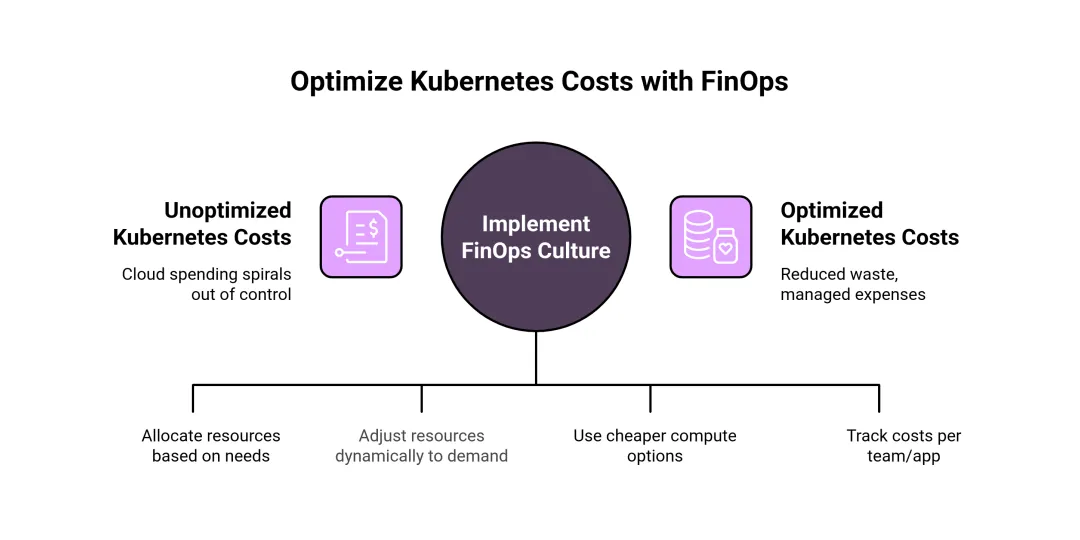October 27, 2025
Are You Missing These Kubernetes Cost Optimization Best Practices & Tools?

By Improwised Editorial Team
Improwised Technologies Pvt. Ltd.
Kubernetes has revolutionized container orchestration, but one hidden cost of this flexibility is cloud spending that can quickly spiral out of control. As cloud adoption grows, optimizing Kubernetes costs isn’t just a technical challenge; rather, it’s a strategic advantage. Explore the best practices and top tools for Kubernetes cost optimization and discover how Improwised Technologies enables smarter cloud spending, especially for enterprises scaling complex workloads.
This blog article will help you in exploring the proven Kubernetes cost optimization best practices, such as right-sizing workloads and storage, enabling automated autoscaling, leveraging spot pricing, and enforcing namespace-level cost controls that teams can achieve meaningful cloud savings without sacrificing application performance. Modern tools and a FinOps-driven culture now make it possible to automate savings, visualize costs in real time, and ensure financial and engineering teams share accountability for every cloud dollar spent.

Why Kubernetes Cost Optimization Matters
Rapid cloud scaling can lead to inefficiencies—overprovisioned resources, underutilized nodes, and suboptimal scaling configurations all result in costly bills.
Primary factors influencing costs consist of:
- Overprovisioning refers to the allocation of excess CPU, memory, or storage resources beyond what is actually required.
- Idle or underutilized resources refer to the maintenance of inactive pods or nodes that remain operational.
- Suboptimal scaling: Failing to utilize integrated cluster and pod autoscaling features.
Through the use of automated, cloud-based Kubernetes cost optimization, organizations can effectively align resources with demand, reduce waste, and manage cloud expenses, even in intricate multi-cloud environments. The emergence of FinOps methodologies introduces enhanced cultural and financial governance, promoting accountability and transparency among engineering, finance, and DevOps teams.
Comprehending Right-sizing in Kubernetes
Right-sizing involves the precise allocation of resources—CPU, memory, storage—based on actual workload requirements rather than relying on fixed estimates.
Optimal methodologies encompass:
- Track real-time consumption: Utilize tools such as Prometheus, Metrics Server, or the native metrics provided by Kubernetes for tracking.
- Configure requests and limits: Define resource requests and hard limits at the pod level to mitigate the risk of unauthorized workloads utilizing excessive resources within the cluster.
- Automated rightsizing tools such as Kubecost, nOps, and Spot Ocean evaluate utilization data and provide recommendations or implement adjustments in real time.
- Evaluate storage distributions: Regularly remove unused persistent volumes and enhance storage classes for better efficiency.
Auto-scaling for Optimal Resource Use
Elastic scaling is one of the major steps for cost optimization. Kubernetes offers a variety of approaches:
- Horizontal Pod Autoscaler (HPA): Adjusts the number of pods dynamically based on CPU, memory, or user-defined metrics.
- Cluster Autoscaler: Dynamically adjusts the number of nodes in response to fluctuations in demand.
- Vertical Pod Autoscaler (VPA): Dynamically modifies pod resource requests and limits in real-time.
Enterprise cost optimization platforms automate scaling, ensuring the cluster adapts dynamically without manual intervention. Smart configuration, such as tuning threshold values and scaling intervals, leads to a reduction in costs while maintaining application performance.
Kubernetes Cost Allocation and Monitoring
Granular cost visibility empowers teams to control spend:
- Tagging and labeling namespaces, workloads: Enables cost tracking and chargeback per team, app, or business unit.
- Implement cost telemetry integration: Integrate usage and expenditure metrics into cloud-based dashboards (e.g., AWS, Azure, GCP).
- Efficient oversight and notification systems: Utilize tools such as Grafana, Kubecost, and then implement real-time alerting mechanisms to identify anomalies and highlight costly jobs.
- Models for FinOps chargeback: Establish a correlation between financial ownership and engineering responsibility to achieve effective governance.
Kubernetes Cost Optimization Tools & Platforms
Leading Kubernetes cost optimization platforms offer:
| Platform | Key Features | AI/ML Capabilities |
|---|---|---|
| Kubecost | Detailed cost allocation, automated tuning | Cost forecasting, anomaly alerts |
| nOps | Real-time optimization, auto rightsizing | Spot instance blending, AI-driven resource suggestions |
| Spot Ocean | Container-driven autoscaling, intelligent bin-packing, headroom scaling | Predictive scaling, spot/reserved/on-demand optimization |
| CAST AI | Automated infrastructure management | ML-based node selection and tuning |
| CloudChipr | Multi-cloud control, reporting, and governance | Resource consumption analytics |
| Zesty | Dynamic rightsizing, commitment automation | ML for scaling and savings |
Many of these tools, designed for businesses, work well with larger platform engineering plans and FinOps methods, providing combined reports, automatic cost management, and shared dashboards for finance and engineering teams.
Best Practices for Cloud-based Kubernetes Cost Optimization
Optimizing Kubernetes costs in the cloud is essential to get a great ROI and obtain sustainable scalability. Here’s a list of key cost optimization best practices for Kubernetes environments that can make a significant difference in your cloud bill and operational efficiency:
-
Implement Continuous Cost Monitoring and Alerting
To reduce the Kubernetes costs effectively, continuous monitoring of resource usage and setting up alerting for anomalies is required. Real-time cost visibility allows teams to identify waste patterns fast, avoid budget overruns, and make data-driven decisions. Tools like CloudZero and Kubecost provide comprehensive dashboards and automatic alerts to support proactive cloud cost control. -
Leverage Discounted Compute Resources
Use cheaper compute options like Spot Instances, preemptible Virtual Machines, and hybrid cloud models for running less important or fault-tolerant workloads. These options significantly reduce cloud spend while maintaining performance. Effective cost optimization platforms automate switching between spot and on-demand instances to maximize savings on bills. -
Use Multi-cloud and Hybrid Cloud Placements
Deploy workloads strategically across multiple clouds or hybrid environments to benefit from regional pricing differences and vendor discounts. Align deployments with cost-effective zones and regions to minimize infrastructure expenses without sacrificing latency or performance. -
Design Stateless Applications
Stateless application design enables seamless scaling and workload shifting across clusters and cloud environments. By decoupling state from compute, applications become easier to scale elastically, incorporate spot or preemptible instances, and leverage automated Kubernetes autoscaling for cost efficiency. -
Collaborate Using FinOps Principles
Promote a culture of shared ownership across finance, engineering, and DevOps teams by adopting FinOps practices. Centralized cost visibility, transparent reporting, and accountability frameworks help optimize Kubernetes cost governance and ensure that cloud spending aligns with business outcomes. -
Optimize Storage and Networking
Regularly audit and prune unused persistent volumes and snapshots to prevent paying for idle storage. Optimize load balancer configurations and minimize unnecessary ingress and egress traffic to reduce network-related cloud costs. -
Strategic Workload Placement
Deploy workloads in cost-efficient regions or availability zones balancing price and latency needs. Intelligent workload placement reduces infrastructure spend and takes advantage of lower-cost capacity where available.
These practices, backed by automated tools and a supportive culture, are essential for effective cloud-based Kubernetes cost optimization, helping organizations grow in a smarter and more cost-effective way.
Multi-cloud and Hybrid Kubernetes Cost Management
Using a mix of cloud providers, such as AWS, GCP, and Azure, offers flexibility but complicates cost control.
- Use multi-cluster management platforms to unify visibility.
- Factor in latency and data transfer costs when distributing workloads.
- Manage cost allocation and reporting across cloud environments to achieve comprehensive savings driven by FinOps.
Real-world Success Stories
Improwised Technologies has assisted a retail client in optimizing idle workloads and fine-tuning auto-scalers, resulting in a 25% reduction in monthly Kubernetes cloud expenditures. In a recent engagement with a client in the finance sector, the implementation of automated rightsizing and namespace-based chargebacks resulted in enhanced cost transparency and a reduction in wasted resources by more than 40%. Not only for these sectors, but our engineering team also focuses on every project on the basis of FinOps culture, merging finance to ensure accountability and foster continuous improvement.
Act Now and Slash Your Kubernetes Costs Now
Proactive, automated Kubernetes cost optimization, especially when rooted in FinOps culture, is a game-changer for any enterprise running cloud-native workloads. The combination of these strategic best practices and robust optimization platforms can turn your organization’s Kubernetes cost chaos into a competitive advantage in this digitally transforming world.
Ready for cluster cost reduction, smarter resource optimization, and actionable insights? Why wait now? Partner with Improwised Technologies to implement best-in-class Kubernetes cost optimization strategies and tools tailored for your enterprise.
Frequently Asked Question
Get quick answers to common queries. Explore our FAQs for helpful insights and solutions.

November 19, 2025
Unlocking Developer Potential: How Platform Engineering Transforms Developer Experience

By Shyam Kapdi
Improwised Technologies
Pvt. Ltd.


By Shyam Kapdi
Improwised Technologies
Pvt. Ltd.

November 14, 2025
How to Build a High-Impact Internal Developer Platform: Step-by-Step Blueprint, Tools, and Best Practices

By Shyam Kapdi
Improwised Technologies
Pvt. Ltd.
Optimize Your Cloud. Cut Costs. Accelerate Performance.
Struggling with slow deployments and rising cloud costs?
Our tailored platform engineering solutions enhance efficiency, boost speed, and reduce expenses.
